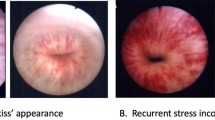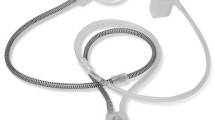Abstract
Use of urethral slings in the treatment of incontinence started in the early 20th century. An evolution in understanding the pathogenesis of urinary incontinence led to development of the midurethral sling, which was designed to replace the natural suburethral vectors of support, as described in the integral theory. Since the introduction of tension-free vaginal tape in 1995, multiple other commercially available types of midurethral sling have been introduced. In general, these sling types share the common characteristics of using a thin, type I synthetic mesh inserted at a midurethral level and applied without tension. The midurethral sling procedure has subsequently undergone multiple technical modifications, predominantly alterations to the technique and route used for sling insertion. Despite the variety in techniques, available evidence suggests that all sling types provide efficacious and durable outcomes. Several adverse effects have been reported that are specific to certain techniques, and include the risk of vascular, enteric or nerve injury, lower urinary tract injury, urinary retention or voiding dysfunction, and vaginal erosion. Nonetheless, the midurethral sling provides a safe surgical option overall, and represents a notable advance in the treatment of stress urinary incontinence.
Key Points
-
The urethral sling has undergone a considerable evolution since its introduction in the early 20th century
-
Introduction of the integral theory advanced our understanding of incontinence, and led to the era of the midurethral sling
-
Multiple midurethral sling types are available, which share the common characteristics of a monofilament mesh placed in a tensionless fashion at a midurethral level
-
Significant data suggest excellent outcomes after sling placement, irrespective of midurethral sling type chosen
-
Specific adverse events are reported, including vascular and enteric injury, urinary voiding dysfunction, and vaginal erosion
-
The midurethral sling represents a notable advance in the treatment of stress urinary incontinence
This is a preview of subscription content, access via your institution
Access options
Subscribe to this journal
Receive 12 print issues and online access
$209.00 per year
only $17.42 per issue
Buy this article
- Purchase on Springer Link
- Instant access to full article PDF
Prices may be subject to local taxes which are calculated during checkout
Similar content being viewed by others
References
Ridley JH (1985) The Goebell-Stoeckel sling operation. In TeLinde's operative gynecology (Eds Mattingly RF and Thompson JP). Philadelphia: Lippincott Williams & Wilkins
Goebell R (1910) Zur operativen Beseitgung der angeborenen Incontinentia Versicae [German]. Dtschr Gynakol Urol 2: 187–191
Frangenheim P (1914) Zur operativen behandlung der Inkontinenz der mannlichen Harnrohe [German]. Verh Dtsch Ges Chir 43: 149–156
Stoeckel EP (1921) Treatment of incontinence of urine in traumatic injuries of the sphincter muscle. Zentralbl Gynakol 45: 17–19
Price PB (1933) Plastics operations for incontinence of urine and feces. Arch Surg 26: 1043–1048
Aldridge AH (1942) Transplantation of fascia for the relief of urinary incontinence. Am J Obstet Gynecol 44: 398–411
Narik G and Palmrich AH (1962) A simplified sling operation suitable for routine use. Am J Obstet Gynecol 84: 400–405
Marshall FV et al. (1949) The correction of stress incontinence by simple vesicourethral suspension. Surg Gynecol Obstet 88: 509–518
Burch JC (1961) Urethrovaginal fixation to Cooper's ligament for the correction of stress incontinence, cystocele and prolapse. Am J Obstet Gynecol 81: 281–290
McGuire EJ and Lytton B (1978) Pubovaginal sling for stress incontinence. J Urol 119: 82–84
Chaikin DC and Blaivas JG (1998) Weakened cadaveric fascial sling: an unexpected cause of failure. J Urol 160 (Pt 1): 2151
Delancey JO (1994) Structural support of the urethra as it relates to stress urinary incontinence: the hammock hypothesis. Am J Obstet Gynecol 170: 1713–1723
Petros PE and Ulmsten UI (1997) An integral theory of female urinary incontinence: experimental and clinical considerations. Acta Obstet Gynecol Scand 166 (Suppl): 3–8
Ulmsten U and Petros P (1995) Intravaginal slingplasty (IVS): an ambulatory surgical procedure for treatment of female urinary incontinence. Scand J Urol Nephrol 29: 75–82
Ulmsten U et al. (1998) A multicenter study of tension-free vaginal tape (TVT) for surgical treatment of stress urinary incontinence. Int Urogynecol J Pelvic Floor Dysfunct 9: 210–213
Delorme E (2001) Transobturator urethral suspension: mini-invasive procedure in the treatment of stress urinary incontinence in women [French]. Prog Urol 11: 1306–1313
de Leval J (2003) Novel surgical technique for the treatment of female stress urinary incontinence: transobturator vaginal tape inside-out. Eur Urol 44: 724–730
Daher N et al. (2003) Pre-pubic TVT: an alternative to classic TVT in selected patients with stress incontinence. Eur J Obstet Gynecol Reprod Biol 107: 205–207
Ulmsten U et al. (1996) An ambulatory surgical procedure under local anesthesia for treatment of female urinary incontinence. Int Urogynecol J Pelvic Floor Dysfunct 7: 81–85
Ulmsten U et al. (1999) A three-year follow-up of tension-free vaginal tape for surgical treatment of female stress urinary incontinence. Br J Obstet Gynecol 106: 345–350
Nilsson CG et al. (2001) Long-term results of the tension-free vaginal tape (TVT) procedure for surgical treatment of female stress urinary incontinence. Int Urogynecol J Pelvic Floor Dysfunct 12 (Suppl 2): S5–S8
Nilsson CG et al. (2004) Seven-year follow-up of the tension-free vaginal tape procedure for treatment of urinary incontinence. Obstet Gynecol 104: 1259–1262
Jeffry L et al. (2001) Objective and subjective cure rates after tension-free vaginal tape for treatment of urinary incontinence. Urology 58: 702–706
Rezapour M and Ulmsten (2001) Tension-free vaginal tape (TVT) in women with mixed urinary incontinence—a long-term follow-up. Int Urogynecol J Pelvic Floor Dysfunct 12 (Suppl 2): S15–S18
Deffieux X et al. (2007) Long-term results of tension-free vaginal tape for female urinary incontinence: follow-up of over 6 years. Int J Urol 14: 521–526
Andonian S et al. (2005) Randomized clinical trial comparing suprapubic arch sling (SPARC) and tension-free vaginal tape (TVT): one-year results. Eur Urol 47: 537–541
Tseng LH et al. (2005) Randomized comparison of suprapubic arc sling procedure vs tension-free vaginal taping for stress incontinent women. Int Urogynecol J Pelvic Floor Dysfunct 16: 230–235
Dalpiaz O et al. (2006) SPARC sling system for treatment of female stress urinary incontinence in the elderly. Eur Urol 50: 826–830
Primus G (2006) One year follow-up on the SPARC sling system for the treatment of female urodynamic stress incontinence. Int J Urol 13: 1410–1414
Deval B et al. (2006) Objective and subjective cure rates after trans-obturator tape (OBTAPE) treatment of female urinary incontinence. Eur Urol 49: 373–377
Spinosa JP and Dubuis PY (2005) Suburethral sling inserted by the transobturator route in the treatment of female stress urinary incontinence: preliminary results in 117 cases. Eur J Obstet Gynecol Reprod Biol 123: 212–217
Giberti C et al. (2007) Transobturator tape for treatment of female stress urinary incontinence: objective and subjective results after a mean follow-up of two years. Urology 69: 703–707
Waltregny D et al. (2007) TVT-O for the treatment of female stress urinary incontinence: results of a prospective study after a 3-year minimum follow-up. Eur Urol 563: 401–410
Lee KS et al. (2007) Outcomes following repeat mid urethral synthetic sling after failure of the initial sling procedure: rediscovery of the tension-free vaginal tape procedure. J Urol 178: 1370–1374
Gandhi S et al. (2006) TVT versus SPARC: comparison of outcomes for two midurethral tape procedures. Int Urogynecol J Pelvic Floor Dysfunct 17: 125–130
Liapis A et al. (2007) Monarc vs TVT-O for the treatment of primary stress incontinence: a randomized study. Int Urogynecol J Pelvic Floor Dysfunct 19: 185–190
Barry C et al. (2007) A multi-centre, randomised clinical control trial comparing the retropubic (RP) approach versus the transobturator approach (TO) for tension-free, suburethral sling treatment of urodynamic stress incontinence: the TORP study. Int Urogynecol J Pelvic Floor Dysfunct 19: 171–178
Zhu L et al. (2007) Comparing vaginal tape and transobturator tape for the treatment of mild and moderate stress incontinence: a prospective randomized controlled trial. Int Urogynecol J Pelvic Floor Dysfunct 99: 14–17
Ward KL and Hilton P (2004) A prospective multicenter randomized trial of tension-free vaginal tape and colposuspension for primary urodynamic stress incontinence: two-year follow-up. Am J Obstet Gynecol 190: 324–331
Novara G et al. (2007) Tension-free midurethral slings in the treatment of female stress urinary incontinence: a systematic review and metaanalysis of randomizd controlled trials of effectiveness. Eur Urol 52: 663–678
Bullock TL et al. (2006) Advances in female stress urinary incontinence: mid-urethral slings. BJU Int 98 (Suppl 1): 32–40
Levin I et al. (2004) Surgical complications and medium-term outcome results of tension-free vaginal tape: a prospective study of 313 consecutive patients. Neurourol Urodyn 23: 7–9
Lukacz ES et al. (2004) The effects of the tension-free vaginal tape on voiding function: a prospective evaluation. Int Urogynecol J Pelvic Floor Dysfunct 15: 32–38
Sander P et al. (2002) Does the tension-free vaginal tape procedure affect the voiding phase? Pressure-flow studies before and 1 year after surgery. BJU Int 89: 694–698
Dietz HP et al. (2004) Voiding function after tension-free vaginal tape: a longitudinal study. Aust NZ J Obstet Gynaecol 44: 152–155
Klutke C et al. (2001) Urinary retention after tension-free vaginal tape procedure: incidence and treatment. Urology 58: 697–701
Segal JL et al. (2004) Prevalence of persistent and de novo overactive bladder symptoms after the tension-free vaginal tape. Obstet Gynecol 104: 1263–1269
Haab F et al. (2001) Results of the tension-free vaginal tape procedure for the treatment of type II stress urinary incontinence at a minimum follow-up of 1 year. J Urol 165: 159–162
Agonstini A et al. (2005) Immediate complications of tension-free vaginal tape (TVT): results of a French survey. Eur J Obstet Gynecol Reprod Biol 124: 237–239
Costa P et al. (2004) Surgical treatment of female stress urinary incontinence with a trans-obturator-tape (T.O.T.) Uratape: short term results of a prospective multicentric study. Eur Urol 46: 102–107
Bemelmans BL and Chapple CR (2003) Are slings now the gold standard treatment for the management of female urinary stress incontinence and if so which technique. Curr Opin Urol 13: 301–307
Abouassaly R et al. (2004) Complications of tension-free vaginal tape surgery: a multi-institutional review. BJU Int 94: 110–113
Kobashi KC and Govier FE (2003) Perioperative complications: the first 140 polypropylene pubovaginal slings. J Urol 170: 1918–1921
Comiter CV and Colegrove PM (2004) High rate of vaginal extrusion of silicone-coated polyester sling. Urology 63: 1066–1070
Young SB et al. (2001) Mersilene mesh sling; short- and long-term clinical and urodynamic outcomes. Am J Obstet Gynecol 185: 32–40
Yamada BS et al. (2006) High rate of vaginal erosions associated with the mentor ObTape. J Urol 176: 651–654
Acknowledgements
Désirée Lie, University of California, Irvine, CA, is the author of and is solely responsible for the content of the learning objectives, questions and answers of the Medscape-accredited continuing medical education activity associated with this article.
Author information
Authors and Affiliations
Corresponding author
Ethics declarations
Competing interests
DE Rapp declared no competing interests.
KC Kobashi is a member of the speaker's bureaus and receives honoraria from Astellas and Novartis. She also works as a consultant for Coloplast.
Rights and permissions
About this article
Cite this article
Rapp, D., Kobashi, K. The evolution of midurethral slings. Nat Rev Urol 5, 194–201 (2008). https://doi.org/10.1038/ncpuro1052
Received:
Accepted:
Published:
Issue Date:
DOI: https://doi.org/10.1038/ncpuro1052
This article is cited by
-
A modified Altis® mid-urethral sling that allows immediate post-operative adjustment: experience in 197 patients
International Urology and Nephrology (2022)
-
Pelvic floor ultrasound: when, why, and how?
Abdominal Radiology (2021)
-
Evaluation of a midurethral single incision sling
Nature Reviews Urology (2010)



